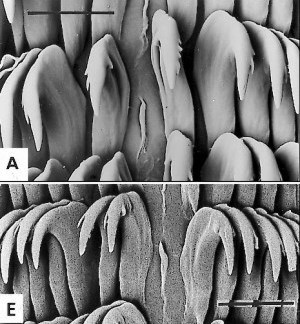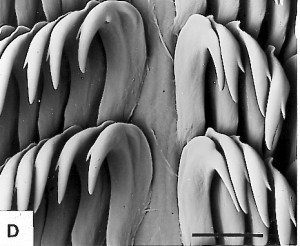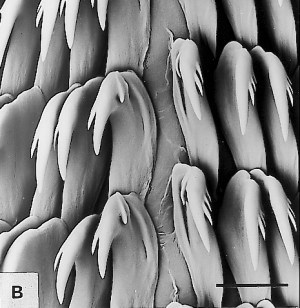Re: Ceratosoma bicolor
August 31, 2001
From: Nishina Masayoshi


Dear Dr.Rudman,
I have just one question on your comments about Ceratosoma bicolor and Ceratosoma trilobatum. Baba mentioned there was a difference between the radular formulae of C. bicolor and C. trilobatum in Opisthobranchia of Sagami Bay.
Isn't this important sometimes? I thought that the radula formula was a good way to identify the animal. However you considered C. bicolor to be a colour form of C. trilobatum?
I am just wondering ... I will be happy if you explain this difference of radula.
Best Regards,
Nishina Masayoshi
nishina@hpe15.wips.co.jp
Nishina, M., 2001 (Aug 31) Re: Ceratosoma bicolor. [Message in] Sea Slug Forum. Australian Museum, Sydney. Available from http://www.seaslugforum.net/find/5138
Dear Nishina,
I am afraid nothing is simple. The shape of the radular teeth and their arrangement is usually a very good way of identifying which family and often which genus a species belongs to. In some cases it can also be a good way of identifying species. Unfortunately in other groups the differences between species are not so clear.
Firstly what is the radula formula? A radula is a ribbon on which there are many teeth arranged in transverse rows. Have a look at the page on the radula of Hypselodoris koumacensis for some photos of a fairly normal chromodorid radula. - In Fig A on that page, you can see a section of the leftside of the radula ribbon showing a few halfrows of teeth. The individual teeth can be differently shaped in different parts of each row. The other photos on that page show teeth from different parts of each row. The radular formula is just a count of the number of teeth in one row multiplied by the number of rows. In the case of H. koumacenisis the formula is 98.0.98 x 65 which means there are about 196 teeth in each row - 98 on each side of the midline. The 0 means that there is no tooth in the midline. The 65 records that there are about 65 rows of teeth in the ribbon.
By comparison, have a look at the page showing the radula of Flabellina poenicia. In that species there are only 3 teeth in each row, one in the centre, and one on each side. The radula formula is 1.1.1 x 12 meaning there are about 12 rows of teeth in the ribbon.
The radular formula can be a useful character but it is not the only important radular character. In species like the chromodorids, which have many teeth in each row, it is a useful way to compare the relative width of the radula ribbon in different species. However the shape of individual teeth and the relative width of the ribbon can alter during the life of an animal, so although the radular teeth can be extremely useful, it needs to be used with caution.
To illustrate this point I have included some photos of the inner radular teeth of a number of specimens of C. trilobatum. A, E, D are all adult animals, and B is a juvenile. A,E,B all show signs of a vestigial central tooth while D does not. The biggest difference is that the juvenile animal (B) has large pointed denticles, while the adults, show either little denticulation or none.
Unfortunately we know very little about C. bicolor. Baba's one specimen (approx 65mm long) had a formula of 48 x 58-65.0.65-58 which I interpret as meaning that there were between 58 and 65 teeth in each half-row. I have looked at the radula of many specimens of C. trilobatum and animal of similar size to Baba's would have a formula of about 80 x 197.0.197. So it is possible that C. bicolor is a good species which can be distinguished on colour and radular characters, but we will need to examine more material to be sure that the one specimen that Dr Baba had available to him was not damaged or aberrant.
Best wishes,
Bill Rudman
Related messages
-
Ceratosoma bicolor? from Japan
From: Nishina Masayoshi, August 22, 2001
